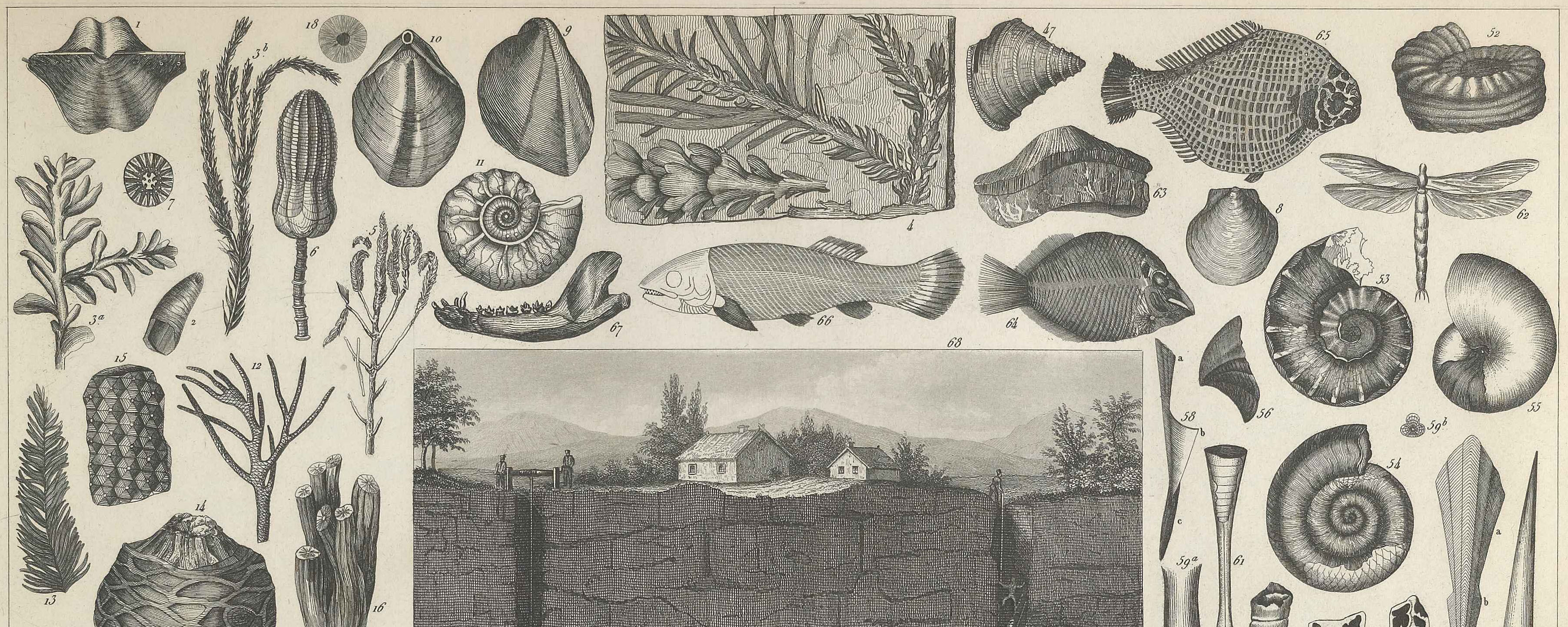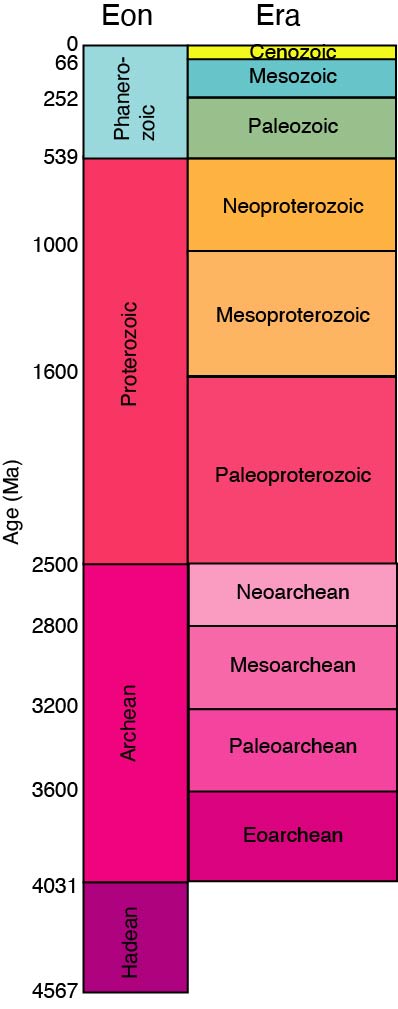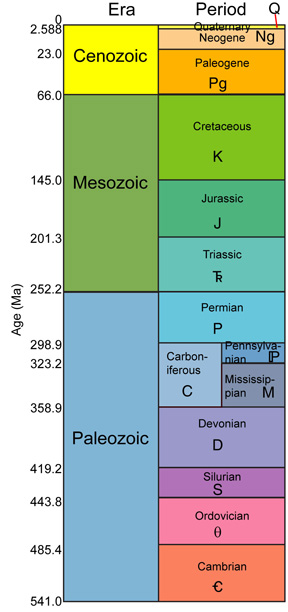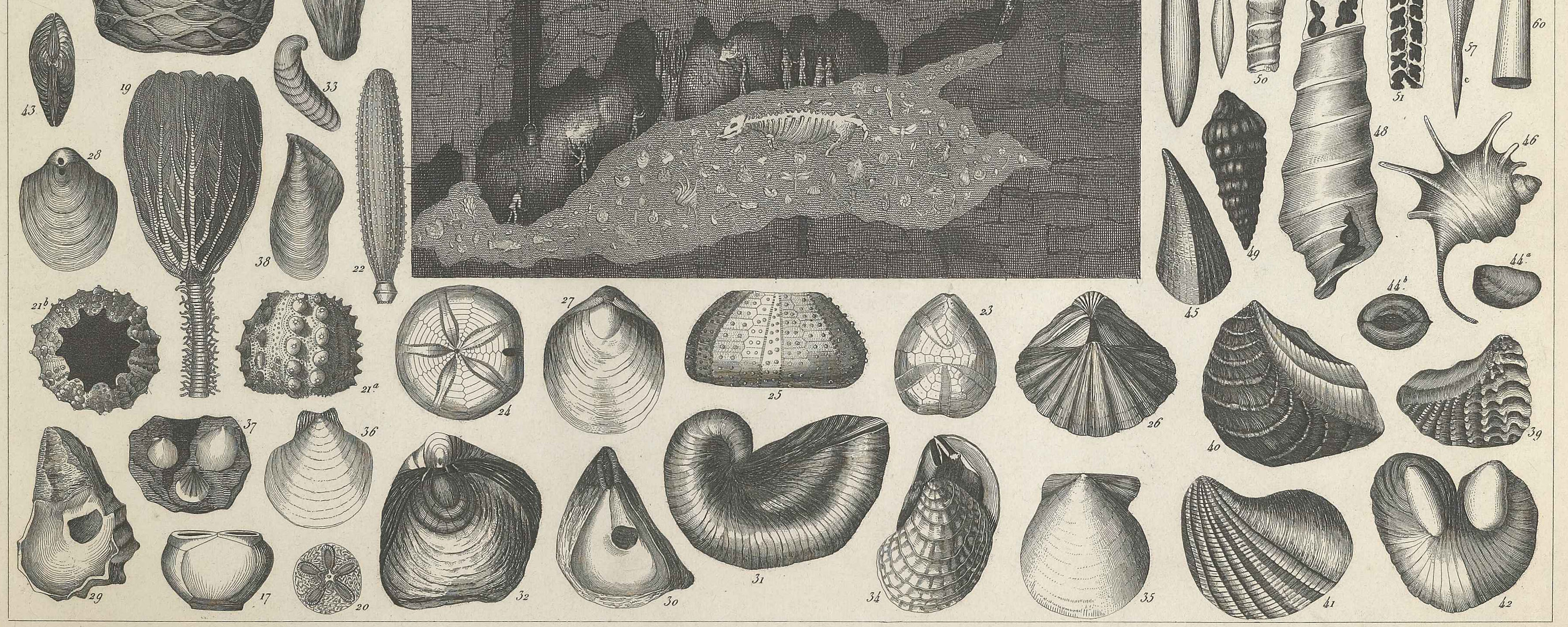


Key Points:
•Paleontology is the study of fossils (the remains or traces of behavior of organisms preserved in the rock record).
•Paleontology can subdivided based on the taxon of study (e.g., vertebrate paleontology; invertebrate paleontology; paleobotany; etc.) or by approach (e.g., stratigraphic paleontology; paleoenvironmental analysis; paleobiology)
•Even below the level of molecules, the isotopic composition of dinosaur bone and teeth contains information about the ecology and physiology of the animals.
"Are there animals and plants peculiar to certain layers, and which are not met with in others? What is the species of those which first appear, or which come after? Are those two species ever found together? Are there variations in their return; or, in other words, do the first again recur, and do the second then disappear? Have these animals and plants all lived in the places where their remains are found, or have some of them been conveyed elsewhere? Do they all exist at present anywhere, or have they been wholly or partly destroyed? Is there a perpetual uniformity between the antiquity of the layers and the resemblance or non-resemblance of the fossils with living beings? Is there a similarity of climate between fossils and those of living beings which most resemble them? Can we determine that the removal of these beings (if there has been any) has been from north to south or from east to west, or by scattering and mixture; and can we distinguish the epochs of those removals by the layers which have these marks impressed on them?" --Baron Georges Cuvier, A Discourse on the Revolutions of the Surface of the Globe: And the Changes Thereby Produced in the Animal Kingdom (1831, English Translation)
What is Paleontology?
Fossils: physical remains of organisms or traces of their behavior preserved in the rock record. Fossils can be roughly divided into:
Paleontology is the scientific study of fossils. More broadly, it is the study of ancient organisms.
One traditional way of dividing up paleontology is along taxonomic lines (i.e., what part of the Tree of Life is being studied). Indeed, professional societies and publications tend to fall along these categories. These general categories are:
However, this is not the only way to divide up the field. Another approach is to consider the types of questions being asked about the fossils:
Paleontology is a science at the cusp of two other larger fields: biology and geology. Because of this, essentially no university has a "Department of Paleontology". Instead, paleontologists might be in either a geology department, a biology department, or both. (A note: in contrast, many natural history museums actually do have full "Departments of Paleontology".).
Paleontologists are expected to know material from both their parent disciplines. From Biology they need information about (and help inform our understanding of) general organismal biology (zoology, botany, etc.), evolutionary biology, ecology, etc. From Geology they need to learn sedimentology, stratigraphy, geochronology, geochemisty, paleonenvironmental analysis, and paleoclimatology. But any given researcher is likely to concentrate on just a few of these for their particular work.
Why should we study fossils? What sort of information do we get from the remains of ancient organisms?
First and foremost, fossils show that life in the past was different than today. If it were not for fossils, there would be no reason to assume that living things had a history (and that said history involved species different than living ones).
Additionally, fossils are our only indication of a succession of ancient forms of life through time. In other words, there was not simply a "prehistoric world", but a succession of "prehistoric worlds".
Fossils document the origins and evolution of the various branches of the Tree of Life. Although we can use the morphology and genomes of extant animals to reconstruct the basic relationships among organisms, living forms do not show the earlier stages of anatomical transitions from their common ancestors. In fact, there are cases where simply looking at modern taxa might be positively misleading (e.g., the transition to a single functional jaw bone in the lower jaw of modern mammals would seem to have come from a single ancestor using only living forms, but is demonstrably convergent between monotremes and the marsupial-placental group when fossils are added.)
Fossils are our only evidence of entirely extinct branches of the Tree of Life. One might be able to predict what the common ancestor of birds and crocodiles was like, or of arachnids and crustaceans, and so forth using living animals (maybe...), but that approach would never reveal the existence of (for instance) sauropod dinosaurs and pterosaurs on the one hand, or trilobites and eurypterids in the second.
The fossil record is the only evidence of mass extinctions. While extinctions of individual species, or even limited extinctions (for example, on islands), have happened within human experience, we would never know that the entire biosphere can undergo tremendous crashes requiring millions of years to recover without fossils. And from that we would never know HOW severe rapid and/or intense environmental changes can be to ecosystems.
The fossil records provides some of the best evidence of environmental change and the only evidence of how organisms respond to environmental change on the long time scale. There are many different methods to reconstruct the climates of the ancient past. At least some of them use the presence/absence, distribution, or isotopic composition of various sorts of fossils.
For a pragmatic issue, fossils are the source of a considerable amount of our energy supply. Coal is comprised of the body fossils of plants; petroleum and natural gas are the decay products of buried organic material (and thus body fossils on at least the chemical level).
And fossils represent aesthetically pleasing objects. We have national and state/provincial parks which highlight beautiful and/or wonderful fossils, and many people collect and display fossils because they are intriguing. In fact, people have been doing this since before we were Homo sapiens.
The fossil record is thus our window onto the history of the life. But how clear is this window? That is, how accurately does the preserved fossil record document the real history of living things.
The basic pattern of the diversity of marine fossils shows an increasing number of taxa, punctuated by mass extinctions. One of the biggest (and unresolved) issues in paleontology is: are there really more species in the modern world? Or is there simply a better record for younger fossils? The latter idea has been termed "The Pull of the Recent" (note: The Recent (capitalized) was a traditional name for the present epoch of geologic time, now formally called the Holocene.)
There are a lot of merits to the concept of the Pull of the Recent:
In fact, some attempts to take these (and other) factors into account suggest that the increase is less profound than previously thought.
However, other studies show that there is a qualitative distinction between ancient (e.g., Ordovician) vs. younger (e.g., Neogene) fossil communities. Examination of well-sampled faunas show that there really does seem to be a distinction in the single-site diversity [number of species] of lower-diversity ancient and higher-diversity modern communities.
Fossils were of course present throughout the history of humans. There are stone tools that predate our own species that show earlier species of our genus Homo collected fossils. How were fossils explained?
In some cases, fossils might be thought to be unusual rocks that happened to look like the parts of living things. Or spill over from the Creation. Or attempts by diabolic forces to create life. Or the bones of dragons, giants, ogres, or other mythical beasts.
Of great importance, though, is how they got into rock in the first place. If rocks are as old as Creation, then they can't be parts of once living things. Since the accumulating evidence showed that they WERE the parts of living things, then rocks cannot be as old as Creation. In other words, rocks were formed sometime between the beginning of the Earth and the present day, and fossils were the remains of living things incorporated into that rock.
The above idea was considered by various thinkers (including Leonardo da Vinci), but most importantly articulated by Nicolas Steno (1638-1686): Danish priest, anatomist, early geologist and paleontologist, and recent honoree of a Google doodle. His 1669 work De solido intra solidum naturaliter contento dissertationis prodromus argued exactly the above: that rocks must be the product of activity within the history of the Earth rather than part of its beginning, and fossils are the remains of dead organisms that were incorporated into their structure. He famously showed that "glossopetrae" ("tongue stones") collected from rocks around the world were in fact the fossilized teeth of sharks.
(Importantly, Steno was primarily an observational scientist rather than a theoretical/philosophical one: his explanations were based on first hand observation of physical evidence (in the field or in the lab) rather than created as thought experiments to fit a particular philosophy.)
Over the next two centuries (1660s to 1860s or so), the basic discoveries of paleontology were established:
Not every taxon is equally likely to become a fossil. Certain factors promote or reduce the chances a particular body becomes buried and survived in sediments.
Biomineralized Hard Parts (aka "skeletons", broadly defined). Many taxon have only soft tissues: from typical amoebae to most algae to jellyfish to nematodes. As such, these groups can only be preserved in the most special circumstances. In contrast, there are organisms that have mineralized or other tough tissues which can be stable in sedimentary depositional environments. Common hard part materials include:
Lived (or at least buried) in Depositional Environments: Another major consideration is whether or not the organism inhabited an environment in which sediment was accumulating. (After all, body fossils are the remains of organisms preserved in the ROCK record.) Thus organisms that live in erosive or non-depositional environments (mountains, rocky coasts, reg deserts, etc.) are very unlikely to be preserved. In contrast, those on the continental shelf, or lakes, or the like have a very good chance of being buried. This is even more true of infaunal benthic organisms (those that live in burrows) and to a somewhat lesser degree epifaunal benthic organisms (those that live on the sediment water interface) than nektonic (swimming) and planktonic (floating) taxa.
But to be clear, since this is really about where the bodies wind up, not the living organism per se. Land-dwelling organisms typically are preserved in aquatic sediments (rivers, lakes, swamps) than in soils, since the latter are less conducive to rapid burial. The pollen record extends over a larger area than that inhabited by the plants that produce them (which often require very specific microhabitats), given that much of pollen is air-dispersed.
There are other factors that influence the preservational potential, which we will address in the next lecture.
So as a consequence, some taxa have an excellent fossil record, whereas others have a lousy one (especially when compared to their relative contributions to the modern fauna.)
Just as a reminder, all GEOL331 students should be familiar with the geologic time scale, and most especially the
Phanerozoic:


From the Cambrian Explosion to the Great Dying (review of the Paleozoic Era):
The Age of Reptiles in Three Acts (review of the Mesozoic Era):
From the Fall of Dinos to the Rise of Humans (review of the Cenozoic Era):
